Link utili:
THOMAS JEFFERSON
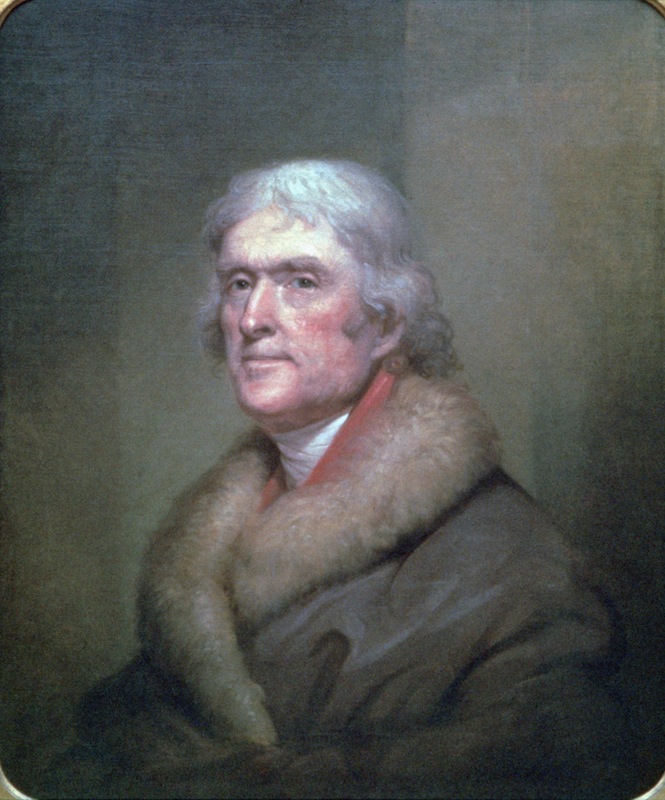
‘Thomas Jefferson’, 1805. (Photo by Art Media/Print Collector/Getty Images)
- Infanzia
Thomas Jefferson è nato il 13 aprile 1743 a Shadwell dove possedeva una vasta piantagione nei pressi dell’attuale Charlottesville, in Virginia (Stati Uniti d’america) ereditata da suo padre. Suo padre, Peter Jefferson (1707 – 1757), era un giudice di pace ma anche un esploratore, elaborò la prima cartina della Virginia con Joshua Fry. Sua madre, Jane Randolph Jefferson (1720-76), proveniva da una famiglia molto ricca della Virginia.Thomas era il loro primo maschio,aveva sei sorelle e un fratello minore. Dal 1752 fino alla morte del padre di quest’ultimo nel 1757 Thomas ebbe come maestro William Douglas (1708-1798), un reverendo scozzese che gli insegnò il greco, il latino e il francese al ritorno della sua famiglia da Tuckahoe a Shadwell.Più tardi Jefferson scrisse del suo insegnante nella sua Autobiografia: “il mio insegnante, Douglas, un pastore scozzese, non era che un latinista superficiale, meno istruito in greco, ma con i rudimenti di queste lingue mi insegnò il francese”. Comunque Jefferson rimase in contatto con il suo primo tutore fino alla sua morte nel 1798.Dopo la morte del padre, Jefferson fu istruito presso un istituto diretto dal pastore James Maury, dove studiò dal 1758 fino al 1760. Come fondatore della Maury School for Boys, Maury ha insegnato a tre futuri presidenti e cinque futuri firmatari della Dichiarazione di indipendenza tra cui Thomas Jefferson, James Madison e James Monroe. Considerata la “più nota” scuola della contea di Albemarle, l’edificio dove insegnava, si trovava al confine delle contee di Albemarle e Louisa. Ha dato lezioni di lingue classiche, costumi, morale, matematica, letteratura, storia e soprattutto la geografia. Maury considerava la conoscenza della geografia come una delle caratteristiche essenziali dell’educazione di un “giovane signore a tutto tondo”. Maury fu anche un esploratore e fece una spedizione per vedere il corso del fiume Mississipi: “Alcune persone dovevano essere mandate alla ricerca di quel fiume Missouri, se questo fosse il nome giusto, per scoprire se aveva qualche comunicazione con l’Oceano Pacifico. Quando si considera quanto sono lontani i rami orientali di quell’immenso fiume [Mississippi], che si estendono verso est, che sono quasi navigabili, che si svuotano nel mare che bagna le nostre coste a est, sembra molto probabile che i suoi rami occidentali raggiungano il punto opposto, e si avvicinino ai fiumi che si svuotano nell’oceano a ovest di noi, l’Oceano Pacifico. ” (James Maury). Nel 1762, Jefferson si diplomò al College of William and Mary a Williamsburg, in Virginia, dove oltre a studiare giurisprudenza si dedicava a suonare il violino per molte ore ogni giorno. Continuò gli studi sotto la tutela di un rispettato avvocato della Virginia e iniziò a lavorare come avvocato nel 1767. Come membro della casa coloniale della Virginia di Burgesses dal 1769 al 1775 Jefferson, che era noto per i suoi modi riservati, ottenne il riconoscimento per aver scritto un opuscolo, “Esposizione sommaria dei diritti dell’America britannica” (1774), che dichiarava che il Parlamento britannico non aveva il diritto di esercitare l’autorità sulle colonie americane.

Monticello: la casa di Thomas Jefferson
- Anni del matrimonio
Nel 1768, Jefferson iniziò a disboscare e ripulire una montagna, in preparazione della casa di mattoni che avrebbe costruito lì, chiamata Monticello. Jefferson, che aveva un forte interesse per l’architettura e il giardinaggio, progettò personalmente la casa e i suoi elaborati giardini. Nel corso della sua vita, rimodellò e ampliò Monticello e lo riempì di opere d’arte, arredi raffinati e dettagli architettonici. Conservava la documentazione di tutto ciò che accadeva nella piantagione, compresi i bollettini meteorologici giornalieri, un diario di giardinaggio e note sui suoi schiavi e sugli animali (documenti che in parte sono stati ritrovati e utili per capire la sua storia). Il 1 ° gennaio 1772, Jefferson sposò Martha Wayles Skelton (1748-82), una giovane vedova. La coppia si trasferì a Monticello e alla fine ebbe sei figli; solo due delle loro figlie – Martha (1772-1836) e Mary (1778-1804) – sopravvissero fino all’età adulta. Nel 1782, la moglie di Jefferson morì a 33 anni di parto. Tuttavia, si ritiene che abbia generato più figli con uno delle sue schiave, Sally Hemings (1773-1835). La schiavitù fu un argomento discusso della vita di Jefferson. Sebbene fosse un sostenitore della libertà individuale e, a un certo punto, promosse un piano per una progressiva emancipazione degli schiavi in America, fu proprietario di schiavi per tutta la sua vita. Inoltre, mentre scriveva nella Dichiarazione di Indipendenza la quale dice che: “tutti gli uomini sono nati uguali”, credeva che gli afroamericani fossero biologicamente inferiori ai bianchi e pensavano che le due razze non potessero coesistere pacificamente nella libertà. Jefferson ereditò circa 175 schiavi da suo padre e da suo suocero e possedette circa 600 schiavi nel corso della sua vita. Ha liberato solo un piccolo numero di loro nella sua volontà; la maggior parte fu venduta dopo la sua morte.

Scansione della Dichiarazione di Indipendenza
- Periodo della rivoluzione americana
Nel 1775, con la rivoluzione americana recentemente in corso, Jefferson fu scelto come delegato al Secondo Congresso Continentale. All’età di 33 anni fu invitato a redigere la Dichiarazione di Indipendenza (prima di iniziare a scrivere, Jefferson discusse i contenuti del documento con un comitato di redazione composta da John Adams e Benjamin Franklin, Robert R. Livingston e Roger Sherman ). Dal 1779 al 1781, Jefferson fu governatore della Virginia, e dal 1783 al 1784, fece un secondo periodo al Congresso (poi ufficialmente noto, dal 1781, come il Congresso della Confederazione). Nel 1785, succedette a Benjamin Franklin (1706-90) come delegato degli Stati Uniti in Francia. I doveri di Jefferson in Europa significavano che non poteva partecipare alla Convenzione costituzionale a Philadelphia nell’estate del 1787; tuttavia, è stato tenuto al corrente del procedimento per redigere una nuova costituzione nazionale e successivamente ha sostenuto l’inclusione di una distinta dei diritti e dei limiti del mandato presidenziale.
- Dichiarazione di indipendenza
La Dichiarazione di Indipendenza, che spiegava perché le 13 colonie volevano essere libere dal dominio britannico e dettagliava anche l’importanza dei diritti e delle libertà individuali, fu adottata il 4 luglio 1776. Il documento inneggia ai diritti inalienabili dell’uomo, uguaglianza, vita, libertà e ricerca della felicità. È il popolo a sciogliere i vincoli politici che lo soffocano, allo stesso modo è il popolo a scegliere il posto che gli spetta di diritto. Il principio dell’indipendenza è il valore primario della democrazia e ha una connotazione divina e naturale (rimando al giusnaturalismo di Locke); Dio ha voluto concedere all’uomo valori etici, e doni.

Logo del partito Democratico-Repubblicano
- Periodo prima della presidenza
Dopo essere tornato in America nell’autunno del 1789, Jefferson accettò un appuntamento dal presidente George Washington (1732-99) per diventare il primo segretario di stato della nuova nazione. In questo posto, Jefferson si è scontrato con il Segretario al Tesoro degli Stati Uniti Alexander Hamilton (1755 / 57-1804) sulla politica estera e le loro diverse interpretazioni della Costituzione degli Stati Uniti. Nei primi anni del 1790, Jefferson, che favoriva il forte stato e il governo locale, co-fondò il Partito Democratico-Repubblicano assieme a James Madison (1808 e 1812), James Monroe (1816 e 1820) e John Quincy Adams (1824) per opporsi al Partito Federalista di Hamilton, che sosteneva un governo nazionale con ampi poteri sull’economia. Nelle elezioni presidenziali del 1796, Jefferson corse contro John Adams e ricevette il secondo maggior numero di voti, che a detta della legge all’epoca lo rendevano vicepresidente. Jefferson corse di nuovo contro Adams nelle elezioni presidenziali del 1800, che si trasformò in un’aspra battaglia tra federalisti e democratici-repubblicani. Jefferson sconfisse Adams; tuttavia, a causa di un difetto nel sistema elettorale, Jefferson ha pareggiato con il collega democratico-repubblicano Aaron Burr (1756-1836). La Camera dei Rappresentanti ha rimediato a questo pareggio e ha votato Jefferson in carica. Per evitare il ripetersi di questa situazione, il Congresso ha proposto il dodicesimo emendamento alla Costituzione degli Stati Uniti, che ha richiesto il voto separato per presidente e vicepresidente. L’emendamento è stato ratificato nel 1804.

Statua di Jefferson situata in Monticello
- Anni della presidenza
Jefferson diventò presidente il 4 marzo 1801; la sua fu la prima inaugurazione presidenziale tenutasi a Washington , DC (quella di George Washington avvenne a New York nel 1789, come quella del suo successore, John Adams, nel 1797.) Invece essere in una carrozza trainata da cavalli, Jefferson ha rotto con la tradizione e ha camminato verso e dalla cerimonia. Jefferson acquistò il territorio della Louisiana dalla Francia per $ 15 milioni nel 1803. Più di 1320000 chilometri quadrati, l’acquisizione (che comprendeva terre che si estendevano tra il fiume Mississippi e le Montagne Rocciose e il Golfo di Dal Messico all’attuale Canada) ha effettivamente raddoppiato le dimensioni degli Stati Uniti. Jefferson quindi commissionò a Meriwether Lewis e William Clark di esplorare la nuova terra. La spedizione, conosciuta oggi come Corps of Discovery, durò dal 1804 al 1806 e fornì preziose informazioni sulla geografia, sulle tribù indiane d’America e sulla vita animale e vegetale della parte occidentale del continente. Nel 1804, Jefferson corse per la rielezione e sconfisse il candidato federalista Charles Pinckney (1746-1825) della Carolina del Sud con oltre il 70% del voto popolare. Durante il suo secondo mandato, Jefferson si concentrò sul tentativo di tenere l’America fuori dalle guerre napoleoniche europee (1803-15). Tuttavia dopo che la Gran Bretagna e la Francia iniziarono a saccheggiare le navi mercantili americane, Jefferson mise l’embargo del 1807. L’atto, che chiuse i porti statunitensi al commercio estero, si rivelò impopolare fra gli americani e ferì l’economia statunitense. Fu abrogato nel 1809 e, nonostante i tentativi del presidente di mantenere la neutralità, gli Stati Uniti finirono per andare in guerra contro la Gran Bretagna nel 1812. Jefferson scelse di non correre per un terzo mandato nel 1808 e gli succedette l’incarico da James Madison (1751-1836), un collega virginiano ed ex segretario di stato americano.
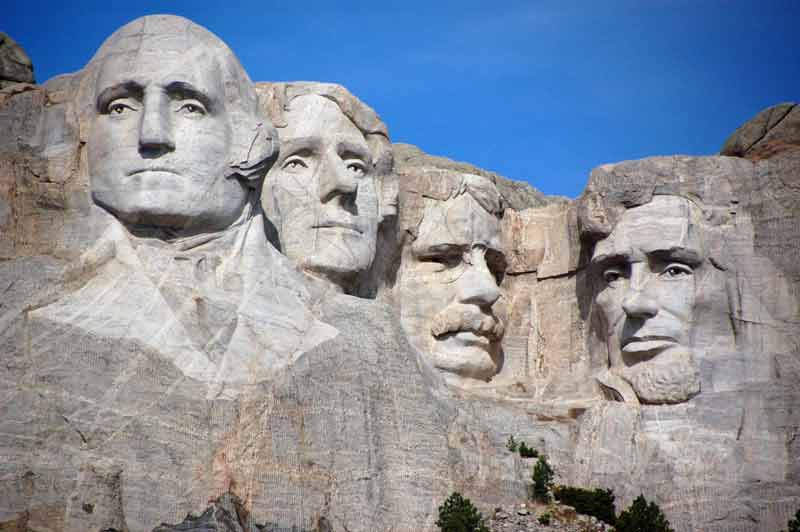
Monte Rushmore
- Ultimi anni della vita di Jefferson
Jefferson trascorse i suoi anni post-presidenziali a Monticello, dove continuò a perseguire i suoi molti interessi, tra cui architettura, musica, lettura e giardinaggio. Aiutò anche a fondare l’Università della Virginia, che tenne le sue prime lezioni nel 1825. Jefferson fu coinvolto nella progettazione degli edifici e del programma scolastico della scuola, e assicurò che a differenza di altri college americani all’epoca, la scuola era totalmente laica (non aveva influenze religiose). Jefferson morì all’età di 83 anni a Monticello il 4 luglio 1826, nel 50 ° anniversario della firma della Dichiarazione di Indipendenza. Per coincidenza, John Adams, amico di Jefferson, ex rivale e compagno firmatario della Dichiarazione di indipendenza, morì lo stesso giorno. Jefferson fu sepolto a Monticello. Tuttavia, a causa del debito significativo che l’ex presidente aveva accumulato durante la sua vita, la sua villa, il suo arredamento e gli schiavi furono venduti all’asta dopo la sua morte. Monticello fu infine acquisito da un’organizzazione senza scopo di lucro, che lo aprì al pubblico nel 1954. Jefferson rimane un’icona americana. La sua faccia appare sul nichelino americano ed è scolpita nella pietra sul monte Rushmore . Il Jefferson Memorial, vicino al National Mall di Washington, è stato dedicato il 13 aprile 1943, il 200 ° anniversario della nascita di Jefferson
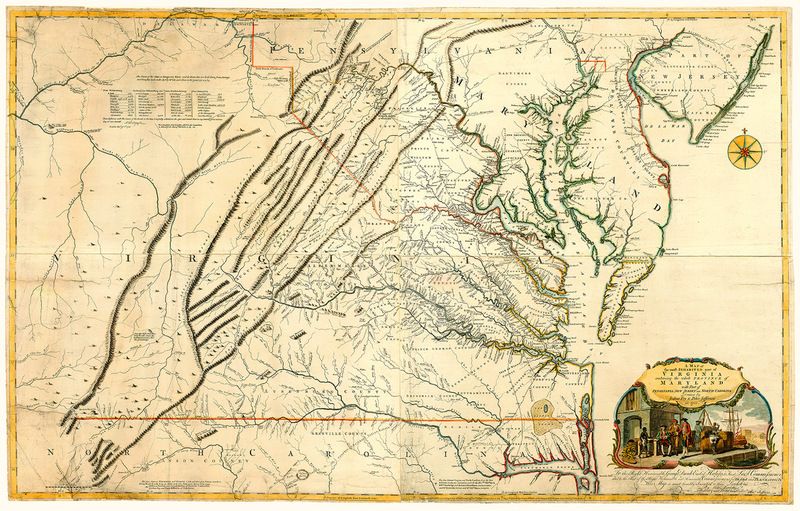
The first map of Virginia that was drawn by Peter Jefferson and Joshua Fry
- Childhood
Thomas Jefferson was born on April 13, 1743 in Shadwell where he owned a large plantation near present-day Charlottesville, Virginia (United States of America) inherited from his father. His father, Peter Jefferson (1707 – 1757) ), was a judge but also an explorer, he drew the first map of Virginia with Joshua Fry. His mother, Jane Randolph Jefferson (1720-76), came from a very wealthy family from Virginia. Thomas was their first male, they had six sisters and a younger brother. From 1752 until the death of his father in 1757 Thomas had as a teacher William Douglas (1708-1798), a Scottish reverend who taught him Greek, Latin and French al ritorno della sua famiglia da Tuckahoe a Shadwell.Più tardi Jefferson scrisse del suo insegnante nella sua Autobiografia: “il mio insegnante, Douglas, un pastore scozzese, non era che un latinista superficiale, meno istruito in greco, ma con i rudimenti di queste lingue mi insegnò il francese”. Comunque Jefferson rimase in contatto con il suo primo tutore fino alla sua morte nel 1798. After his father’s death, Jefferson was educated at an institute headed by Pastor James Maury, where he studied from 1758 until 1760. As the founder of the Maury School for Boys, Maury taught three future presidents and five future signatories of the Declaration of Independence including Thomas Jefferson, James Madison and James Monroe. Considered the “best known” school in the Albemarle county, the building where he taught was in the border of the counties of Albemarle and Louisa. He taught him classical languages, mathematics, literature, history and above all geography. Maury considered knowledge of geography as one of the essential characteristics of the education of a man. Maury was also an explorer and he went to see the course of the Mississippi River: “Some people had to be sent for research. of that Missouri River, if this was the right name, to find out if it had any communication with the Pacific Ocean. When one considers how far the eastern branches of that immense river [Mississippi], which extend eastwards, are almost navigable, that are emptied into the sea that bathes our coasts to the east, it seems very probable that its western branches reach the opposite point, and approach the rivers that are empty in the ocean west of us, the Pacific Ocean. “(James Maury). In 1762, Jefferson graduated from the College of William and Mary in Williamsburg, Virginia, where in addition to studying law he played the violin for many hours each day. He continued his studies under from a respected Virginia lawyer and began working as a lawyer in 1767. As a member of Virginia’s Burgesses colonial house from 1769 to 1775, Jefferson, gained recognition for having written a pamphlet, “Summary Exposure of the Rights of British America” (1774), which declared that the British Parliament had no right to exercise authority over the American colonies.

Portrait of Martha Wayles Skelton who was the wife of Thomas Jefferson
- Wedding’s years
In 1768 Jefferson started to clear a mountain for the construction of the brick house called Monticello. Jefferson, who had a strong interest in architecture and gardening, personally designed the house and its elaborate gardens. During his life, he remodeled and expanded Monticello and filled it with works of art, fine pieces of furniture and architectural details. He kept trak of everything that happened in the plantation, including daily weather reports, a gardening diary and notes about his slaves and animals (documents that were partly found and useful for understanding his life). On January 1, 1772, Jefferson married Martha Wayles Skelton (1748-82), a young widow. The couple moved to Monticello and had six children; but only two of their daughters Martha (1772-1836) and Mary (1778-1804) survived into adulthood. In 1782, Jefferson’s wife died at 33 years of childbirth. However, it is believed that he generated more children with one of his slaves, Sally Hemings (1773-1835). Slavery was a topic discussed in Jefferson’s life. Although he was a supporter of individual liberty and, at some point, promoted a plan for a progressive emancipation of slaves in America, he was a owner of slaves throughout his life. Also, while he wrote in the Declaration of Independence which says that “all men were born equal”, he believed that African Americans were biologically inferior to whites and thought that the two races could not coexist peacefully in freedom. Jefferson inherited about 175 slaves from his father and his father-in-law and owned about 600 slaves during his life. He released only a small number of them in his will; most were sold after his death.
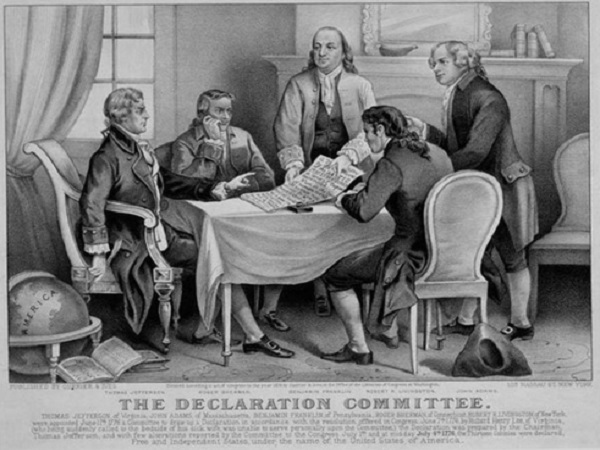
Picture of John Adams, Thomas Jefferson, Benjamin Franklin, Robert R. Livingston and Roger Sherman (this group was called the declaration committee)
- Years of american revolution
In 1775, during the American revolution recently under way, Jefferson was chosen as a delegate to the Second Continental Congress. At the age of 33 he was invited to create the Declaration of Independence (before starting to write, Jefferson discussed the contents of the document with John Adams and Benjamin Franklin, Robert R. Livingston and Roger Sherman). From 1779 to 1781, Jefferson was governor of Virginia, and from 1783 to 1784, he made a second term at the Congress (later officially known, from 1781, as the Congress of the Confederacy). In 1785, he succeeded Benjamin Franklin (1706-90) as a delegate of the United States in France.
- Indipendence declaration
The Declaration of Independence, which explained : why the 13 colonies wanted to be free from UK and also the importance of individual rights and freedoms. The declaration was adopted on July 4, 1776. The document praises the inalienable rights of man, equality, life, freedom and the pursuit of happiness. The principle of independence is the primary value of democracy and has a divine and natural connotation (referring to Locke’s natural law); God wanted to give man ethical values and gifts.
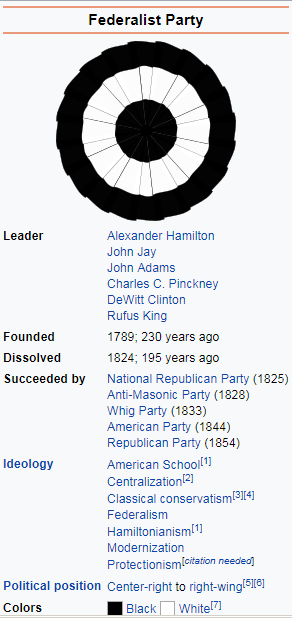
logo of the Federalist party
- Period before the presidency
After returning to America in the autumn of 1789, Jefferson became the first secretary of state for the new nation. Jefferson clashed with US Treasury Secretary Alexander Hamilton (1755 / 57-1804) on foreign policy and their different interpretations of the US Constitution. In the early 1790s, Jefferson, who favored the strong state and local government, co-founded the Democratic-Republican Party along with James Madison (1808 and 1812), James Monroe (1816 and 1820) and John Quincy Adams (1824) to oppose to the Hamilton Federalist Party. In the presidential election of 1796, Jefferson ran against John Adams and received the second highest number of votes, which according to the law at the time made him vice president. Jefferson ran again against Adams in the presidential election of the 1800s, which turned into a battle between federalists and republican-democrats. Jefferson defeated Adams; however, due to a flaw in the electoral system, Jefferson drew with his Democrat-Republican counterpart Aaron Burr (1756-1836). The House of Representatives remedied this tie and voted Jefferson in charge. To avoid the repetition of this situation, Congress proposed the twelfth amendment to the US Constitution, which required a separate vote for president and vice president. The amendment was ratified in 1804.
 Map of the purchase of Louisiana
Map of the purchase of Louisiana
- Years of the presidency
Jefferson became president on March 4, 1801; his was the first presidential inauguration held in Washington, DC (that of George Washington took place in New York in 1789, as one of his successor, John Adams, in 1797.) Instead of being in a horse-drawn carriage, Jefferson broke with tradition and walked towards and from the ceremony. Jefferson purchased Louisiana territory from France for $ 15 million in 1803. More than 13,000,000 square kilometers, the acquisition (which included lands that stretched between the Mississippi River and the Rocky Mountains and the Gulf of Mexico to present-day Canada) has actually doubled the size of the United States. Jefferson then commissioned Meriwether Lewis and William Clark to explore the new land. The expedition, known today as the Corps of Discovery, lasted from 1804 to 1806 and provided valuable information on geography, the Indian tribes of America and the animal and plant life of the western part of the continent. In 1804, Jefferson ran for re-election and defeated the federalist candidate Charles Pinckney (1746-1825) of South Carolina with over 70% of the popular vote. During his second term, Jefferson focused on trying to keep America out of the European Napoleonic wars (1803-15). However, after Britain and France began to plunder American merchant ships, Jefferson put the embargo of 1807. The act, which closed US ports to foreign trade, turned out to be unpopular among the Americans and wounded the US economy . It was repealed in 1809 and, despite the president’s attempts to maintain neutrality, the United States ended up going to war against Britain in 1812. Jefferson chose not to run for a third term in 1808 and was succeeded by James Madison (1751-1836), a virginian colleague and former US secretary of state.
 Jefferson nickel
Jefferson nickel
- Last years of Jefferson’s life
Jefferson spent his post-presidential years in Monticello, where he continued to pursue his many interests, including architecture, music, reading and gardening. He also helped found the University of Virginia, which held its first lessons in 1825. Jefferson was involved in the design of the school buildings and school program, and assured that unlike other American colleges at the time, the school was totally laic (had no religious influences). Jefferson died at the age of 83 in Monticello on July 4, 1826, on the 50th anniversary of the signing of the Declaration of Independence. Coincidentally, John Adams, a friend of Jefferson, a former rival and fellow signer of the Declaration of Independence, died the same day. Jefferson was buried in Monticello. However, due to the significant debt that the former president had accumulated during his life, his villa, its furnishings and slaves were sold at auction after his death. Monticello was eventually acquired by a non-profit organization, which opened it to the public in 1954. Jefferson remains an American icon. His face appears on the American nickel and is carved in the stone on Mount Rushmore. The Jefferson Memorial, near the National Mall in Washington, was dedicated on April 13, 1943, the 200th anniversary of the birth of Jefferson
ARTICOLO REDATTO DALL’ ALUNNO MARCO CAVAGNETTO DELLA CLASSE IV A DEL LICEO CLASSICO SOTTOLA SUPERVISIONE DELLA PROF. ORIANA MAFFEO E DEL PROF. MARCO CASTELLI

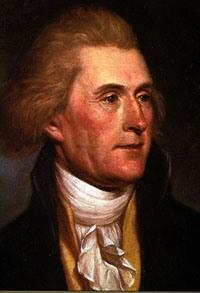
Commenti recenti